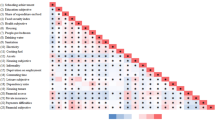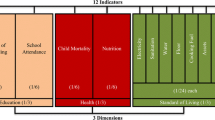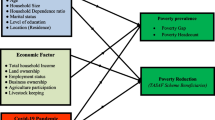Abstract
Recent work has shown that the gender gap in income poverty has widened in post-apartheid South Africa even though overall poverty levels have declined. One of the main criticisms of money-metric studies of gendered poverty differences is that income is only one dimension of poverty and that other measures of welfare may better reflect the relative well-being of women and female-headed households. This article presents a multidimensional approach to measuring the gender poverty gap in post-apartheid South Africa. Using data from the 2008 wave of the South African National Income Dynamic Study, the internationally comparable multidimensional poverty index (the MPI) is used to estimate gender differences in a number of different achievements. The findings suggest that the multidimensional gender poverty gap is similar to the poverty gap measured by the conventional money-metric approach at several national poverty lines. However, the MPI poverty differential between female- and male-headed households is slightly narrower than the income poverty gap between these two household types. In order to explore these findings further, the paper decomposes the components of multidimensional poverty by gender and for both female- and male-headed households. The paper concludes by considering how greater investments in health care delivery and in basic services, particularly in rural areas, may yield progress towards gender equality.




Similar content being viewed by others
Notes
Government expenditure on social grants increased in the post-2000 period (starting in 2001–2002) with the proportion of gross domestic product (GDP) spent on social grants rising from about 2 per cent in 1994 to 3.5 per cent in 2005 (Seekings 2007). In real terms, annual government expenditure on non-contributory social grants more than doubled between 1994 and 2006 (from <R20 billion in 1994 to just over R40 billion in 2006- in 2000 prices) (Seekings 2007). The social grant with the single largest number of beneficiaries, the state pension, has a strong gender dimension since women (until 2007) were eligible for the grant at an earlier age and because women tend to live longer than men. Accordingly, roughly three quarters of the grant are awarded to women (Burns et al. 2005). Roughly two-thirds of the income from the poorest income quintile is derived from social grants and most of this income comes from the three child grants (i.e. the Child Support Grant, Care Dependency Grant and the Foster Care Grant) (Leibbrandt et al. 2010). In particular, the Child Support Grant is predominantly awarded (roughly 77 per cent of all CSGs in 2005) to working-age African women (on behalf of children) (Williams 2007).
Labour force data show that roughly half of the growth in female employment between the mid-1990s and 2001 can be attributed to jobs in the informal sector (Casale 2004; Casale and Posel 2002). Moreover, between 1995 and 2001 roughly a quarter of the total female workforce remained in the domestic sector while the percentage that was engaged in informal self-employment increased dramatically from 6 to 20.6 per cent (Casale 2004). The increase in female employment was, therefore, largely concentrated in the informal sector where wages are lower, employment is less secure and benefits are non-existent.
However, there has been some work which has considered other non-income measures of gender inequality— e.g. asset based measures of poverty (see Deere et al. 2012).
In 2010, the MPI replaced the Human Development Index (HDI) as the official way in which the UNDP ranks countries.
The 2003 Demographic and Health Survey is another potential data source but the data are not widely available to researchers and there are a number of well documented concerns with data quality (Finn et al. 2013).
This poverty line is very close to the poverty line of R322 per capita monthly income (in 2000 prices) that has been widely used in the post-apartheid poverty literature (Statistics South Africa 2008).
The MPI headcount is expected to be far lower than poverty headcounts at South Africa’s official poverty lines because it was designed as a measure of ‘acute’ deprivation (Alkire and Santos 2010). As such, the cut-offs assigned for each indicator denote ‘deprivations in very rudimentary services and core human functionings’ (Alkire and Santos 2010, p. 7).
The food poverty line is calculated as the minimum level at which an individual could survive in terms of caloric intake. The equivalent money-metric line of R142 is therefore well below even the lowest possible poverty line that is used in the South African context. However, because the analysis is concerned with gender differences in well-being the equivalent line is used for comparison purposes only and is not intended to denote a particular level of resources at which an individual or household is considered poor.
The sex poverty ratio is measured as the ratio of women’s poverty to men’s poverty such that, when the ratio is >1, women are more likely to be poor than men (see McLanahan et al. 1989).
Individuals are poor if they live in a household which is deprived in more than a third of the weighted indicators identified in Table 1.
The censored headcount is the proportion of the population multidimensionally poor and simultaneously deprived in a particular indicator.
One potential limitation of the MPI measure is that individuals living in households with no children (or no history of children) are identified as non-deprived in school attendance and child mortality (as are households with no women). To some extent, then, the global MPI is sensitive to the composition of households. Santos and Alkire (2011), however, report preliminary evidence suggesting that the bias of MPI measures to households with children and women of reproductive age is not significant.
About 39 per cent of all female-headed households live in rural areas compared with about 30 per cent of male-headed households. Moreover, a third of female-headed households live in traditionally under-serviced former tribal areas but only 20 per cent of male-headed households are located in these areas (own calculations from NIDS 2008).
Meth (2014, p. 151) writes of the MPI in South Africa, ‘… if the dimensions of health, education and standard of living, and the set of indicators by which they can be measured were really guided by the capabilities approach, then either the approach itself, or their use of it is too blame for the fact that they could not even detect a major epidemic, a health and education sector in crisis, and large-scale social unrest because of delivery failure on the part of the South African government’.
References
Agbodji, A., Batana, Y., & Ouedraogo, D. (2013). Gender inequality in multidimensional welfare deprivation in West Africa: The case of Burkina Faso and Togo. Policy Research Working Paper No. 6522. Washington: The World Bank.
Albelda, R. (1999). Women and poverty: Beyond earnings and welfare. The Quarterly Review of Economics and Finance, 39, 723–742.
Alkire, S. (2007). The missing dimensions of poverty data: An introduction. Oxford Development Studies, 35(4), 347–359.
Alkire, S., Apablaza, M., & Jung, E. (2012a). Multidimensional poverty measurement for EU-SILC (European Union Statistics on Income and Living Conditions) countries. OPHI Research in Progress No. 36a. Oxford: Oxford Poverty and Human Development Initiative (OPHI), Oxford Department of International Development, University of Oxford.
Alkire, S., & Foster, J. (2011a). Counting and multidimensional poverty measurement. Journal of Public Economics, 95, 476–487.
Alkire, S., & Foster, J. (2011b). Understandings and misunderstandings of multidimensional poverty measurement. The Journal of Economic Inequality, 9(3), 289–314.
Alkire, S., Meinzen-Dick, R., Peterman, A., Quisumbing, A., Seymour, G, & Vaz, A. (2012b). The Women’s empowerment in agriculture index. IFPRI Discussion Paper No. 01240. Washington: International Food Policy Research Institute.
Alkire, S., & Santos, M. E. (2010). Acute multidimensional poverty: A new index for developing countries. OPHI Working Paper No. 38. Oxford: Oxford Poverty and Human Development Initiative (OPHI), Oxford Department of International Development, University of Oxford.
Anand, S., & Sen, A. (1997). Concepts of human development and poverty: A multidimensional perspective. Human Development Papers 1997: Poverty and Human Development. New York: UNDP.
Atkinson, A. B. (2003). Multidimensional deprivation: Contrasting social welfare and counting approaches. Journal of Economic Inequality, 1(1), 51–65.
Bastos, A., Casaca, S., Nunes, F., & Pereirinha, J. (2009). Women and poverty: A gender-sensitive approach. The Journal of Socio-Economics, 38, 764–778.
Batana, Y. (2013). Multidimensional measurement of poverty among women in Sub-Saharan Africa. Social Indicators Research, 112, 337–362.
Bhorat, H., Naidoo, P., & van der Westhuizen, C. (2006). Shifts in non-income welfare in South Africa: 1993–2004. DPRU Working Paper No. 06/108. Cape Town: Development Policy Research Unit, University of Cape Town.
Bhorat, H. & van der Westhuizen, C. (2008). Economic growth, poverty and inequality in South Africa: The first decade of democracy. Paper presented at the Development Policy Research Unit Conference 2008, Gauteng.
Botti, F., Corsi, M., & D’Ippoliti, C. (2012). The gendered nature of multidimensional poverty in the European Union. CEB Working Paper No. 12/026. Brussels: Solvay Brussels School of Economics and Management, Centre Emile Bernheim.
Bourguignon, F., & Chakravarty, S. (2003). The measurement of multidimensional poverty. Journal of Economic Inequality, 1(1), 5–49.
Budlender, D. (2003). The debate about household headship. Social Dynamics, 29(2), 48–72.
Burns, J., Keswell, M., & Leibbrandt, M. (2005). Social assistance, gender, and the aged in South Africa. Feminist Economics, 11(2), 103–115.
Casale, D. (2004). What has the feminisation of the labour force ‘bought’ women in South Africa? Trends in labour force participation, employment and earnings, 1995–2001. DPRU Working Paper No. 04/84. Cape Town: Development Policy Research Unit, University of Cape Town.
Casale, D., & Posel, D. (2002). The continued feminisation of the labour force in South Africa: An analysis of recent data and trends. The South African Journal of Economics, 70(1), 156–184.
Catagay, N. (1998). Gender and poverty. UNDP Working Paper No. 5. United Nations Development Programme.
Chant, S. (2003a). Female household headship and the feminisation of poverty: Facts, fictions and forward strategies. New Working Paper Series No. 9. London: LSE Gender Institute, London School of Economics and Political Science.
Chant, S. (2003b). New contributions to the analysis of poverty: Methodological and conceptual challenges to understanding poverty from a gender perspective. Paper presented at the Experts Meeting on Gender and Poverty, Santiago.
Deere, C., Alvarado, G., & Twyman, J. (2012). Gender inequality in asset ownership in Latin America: Female owners vs household heads. Development and Change, 43(2), 505–530.
Deere, C., & Doss, C. (2006). The gender asset gap: What do we know and why does it matter? Feminist Economics, 12(1–2), 1–50.
Dinkelman, T. (2011). The effects of rural electrification on employment: New evidence from South Africa. The American Economic Review, 101(7), 3078–3108.
Duflo, E. (2003). Grandmothers and granddaughters: Old-age pensions and intrahousehold allocation in South Africa. The World Bank Economic Review, 17(1), 1–25.
Duflo, E. (2012). Women empowerment and economic development. Journal of Economic Literature, 50(4), 1051–1079.
Ele-Ojo Ataguba, J., Ichoku, H., & Fonta, W. (2013). Multidimensional poverty assessment: Applying the capability approach. International Journal of Social Economics, 40(4), 331–354.
Fantahun, M., Berhane, Y., Wall, S., Byass, P., & Hogberg, U. (2007). Women’s involvement in household decision-making and strengthening social capital-crucial factors for child survival in Ethiopia. Acta Paediatrica, 96, 582–589.
Findlay, J., & Wright, R. (1996). Gender, poverty and the intra-household distribution of resources. Review of Income and Wealth, 42(3), 335–351.
Finn, A., Franklin, S., Keswell, M., Leibbrandt, M., & Levinsohn, J. (2009). Expenditure: Report on NIDS wave 1 NIDS Technical Paper No. 4. Cape Town: Southern African Labour & Development Research Unit, University of Cape Town.
Finn, A., Leibbrandt, M., & Woolard, I. (2013). What happened to multidimensional poverty in South Africa between 1993 and 2010?. Southern Africa Labour and Development Research Unit Working Paper No. 99. Cape Town: SALDRU, University of Cape Town.
Francisco, J. (2007). Gender inequality, poverty and human development in South East Asia. Development, 50, 103–114.
Fukuda-Parr, S. (1999). What does feminization of poverty mean? It isn’t just lack of income. Feminist Economics, 5(2), 99–103.
Heath, R. (2012). Women’s access to labor market opportunities, control of household resources, and domestic violence. World Bank Policy Research Working Paper No. 6149. Washington DC: The World Bank.
Klasen, S. (2000). Measuring poverty and deprivation in South Africa. Review of Income and Wealth, 46(1), 33–58.
Klasen, S. (2004). Gender-related indicators of well-being. Discussion Paper No. 2004/05: World Institute for Development Economic Research, United Nations University.
Lanjouw, J. (2012). Counting women in poverty: Potential pitfalls in conventional poverty analysis. Paper presented at the PREM Knowledge and Learning Weeks, Washington.
Leibbrandt, M., Woolard, I., Finn, A., & Argent, J. (2010). Trends in South African income distribution and poverty since the fall of apartheid. OECD Social, Employment and Migration Working Paper No. 101. Organisation for Economic Co-operation and Development.
McLanahan, S. S., Sorenson, A., & Watson, D. (1989). Sex differences in poverty, 1950–1980. Signs, 15(1), 102–122.
Meth, C. (2014). No teeth, but lovely gums! A critique of Sen’s ‘capability’ approach to poverty and the Alkire Foster Multi-Dimensional Poverty Indices it has spawned. Sheffield: Samland Press.
Møller, V. (2007a). Researching quality of life in a developing country: Lessons from the South African case. In I. Gough & J. McGregor (Eds.), Wellbeing in developing countries: From theory to research (pp. 242–258). Cambridge: Cambridge University Press.
Møller, V. (2007b). Satisfied and dissatisfied South Africans: Results from the General Household Survey in international comparison. Social Indicators Research, 81(2), 389–415.
Møller, V. (2012). South African quality of life trends over three decades, 1980–2010. Social Indicators Research, 113(3), 915–940.
Momsen, J. H. (2002). Myth or math: The waxing and waning of the female-headed household. Progress in Development Studies, 2(2), 145–151.
OECD. (2010). Gender Inequality and the MDGs:What are the Missing Dimensions?. OECD Development Centre Position Paper No. 2. Paris: The Organisation for Economic Co-operation and Development.
Oxford Poverty and Human Development Initiative. (2011). Country briefing: South Africa: Multidimensional Poverty Index (MPI) at a glance. Oxford: Oxford Department of International Development.
Posel, D. (2001). Who are the heads of household, what do they do, and is the concept of headship useful? An analysis of headship in South Africa. Development Southern Africa, 18(5), 651–670.
Posel, D., & Casale, D. (2011). Relative standing and subjective well-being in South Africa: The role of perceptions, expectations and income mobility. Social Indicators Research, 104(2), 195–223.
Posel, D., & Rogan, M. (2009). Women, income and poverty: Gendered access to resources in post-apartheid South Africa. Agenda, 23(81), 25–34.
Posel, D., & Rogan, M. (2012). Gendered trends in poverty in the post-apartheid period, 1997–2006. Development Southern Africa, 29(1), 97–113.
Posel, D., & Rogan, M. (2014). Measured as poor versus feeling poor: Comparing money-metric and subjective poverty rates in South Africa. WIDER Working Paper 2014/133. Helsinki: World Institute for Development Economics Research- United Nations University.
Robeyns, I. (2003). Sen’s capability approach and gender inequality: Selecting relevant capabilities. Feminist Economics, 9(2–3), 61–92.
Rogan, M. (2013a). Alternative definitions of headship and the ‘feminisation’ of income poverty in post-apartheid South Africa. Journal of Development Studies, 49(10), 1344–1357.
Rogan, M. (2013b). Poverty and headship in post-apartheid South Africa, 1997–2006. Social Indicators Research, 113(1), 491–511.
Santos, M. E., & Alkire, S. (2011). Training material for producing national human development reports. In M. E. Santos & S. Alkire (Eds.), MPI: Construction and analysis. Oxford: Oxford Poverty and Human Development Initiative.
Schatz, E. (2007). Taking care of my own blood: Older women’s relationships to their households in rural South Africa. Scandinavian Journal of Public Health, 35(3), 147–154.
Seekings, J. (2007). Deserving individuals and groups: Justifying the shape of South Africa’s welfare state. CSSR Working Paper No. 193. Cape Town Centre for Social Science Research.
Sen, A. (1985). Commodities and Capabilities. Amsterdam: North-Holland.
Sen, A. (1993). Capability and well-being. In M. Nussbaum & A. Sen (Eds.), The quality of life (pp. 30–53). Oxford: Clarendon Press.
Sen, A. (1999). Development as freedom. New York: Knopf.
Sen, A. (2000). A decade of human development. Journal of Human Development, 1(1), 17–23.
Statistics South Africa. (2008). Measuring poverty in South Africa: Poverty lines for statistical reporting technical report. Pretoria: Statistics South Africa.
Stiglitz, J., Sen, A., & Fitoussi, J. -P. (2009). Report by the Commission on the Measurement of Economic Performance and Social Progress, Paris.
Vijaya, R., Lahoti, R., & Swaminathan, H. (2013). Moving from the household to the individual: Multidimensional poverty analysis. Indian Institute of Management Bangalore Working Paper No. 404. Bangalore: Indian Institute of Management Bangalore.
Vijaya, R., Lahoti, R., & Swaminathan, H. (2014). Moving from the household to the individual: Multidimensional poverty analysis. World Development, 59, 70–81.
Williams, M. (2007). The social and economic impacts of South Africa’s Child Support Grant. EPRI Working Paper No. 40. Cape Town: Economic Policy Research Institute.
Author information
Authors and Affiliations
Corresponding author
Rights and permissions
About this article
Cite this article
Rogan, M. Gender and Multidimensional Poverty in South Africa: Applying the Global Multidimensional Poverty Index (MPI). Soc Indic Res 126, 987–1006 (2016). https://doi.org/10.1007/s11205-015-0937-2
Accepted:
Published:
Issue Date:
DOI: https://doi.org/10.1007/s11205-015-0937-2




